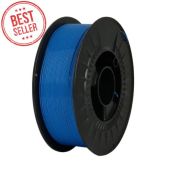We use cookies to make your experience better. Read more
10 Agosto, 2024
What is PLA Filament? A Beginner’s Guide to 3D Printing Materials
Understanding PLA Filaments
PLA (Polylactic Acid) is one of the most widely used 3D printer filaments, known for its versatility, extensive color range, and aesthetic appeal. PLA is particularly favored by those seeking high-quality, vibrant, and visually pleasing 3D prints. Its ease of use makes it an ideal choice for beginners looking to experiment with 3D printing. But what exactly makes PLA one of the best filaments for 3D printing?
What is PLA Filament?
PLA filament is an eco-friendly 3D printing material derived from organic sources such as corn starch and sugarcane. The production of this thermoplastic monomer is what sets it apart from other filaments, as it uses biomass resources, making it both sustainable and environmentally friendly. PLA is biodegradable, requires 65% less energy to produce compared to traditional plastics, and emits 68% fewer greenhouse gases during production. Additionally, it does not contain toxins, making it a safer choice for various printing applications.
How is PLA Filament Made?
PLA filament is produced through the fermentation of starch from plants like maize, sugarcane, or cassava. This fermentation process transforms the raw materials into lactic acid, which is then used to create PLA. The filament can be produced using two primary methods: Direct Condensation Polymerization and Ring Opening Polymerization (ROP).
Ring-Opening Polymerization (ROP):
- Formation of Lactide (Cyclic Dimer): Lactic acid is first converted into lactide, a cyclic dimer, through a condensation process.
- Ring-Opening Polymerization: The lactide undergoes ring-opening polymerization, usually with a catalyst (commonly tin-based like tin(II) octanoate), producing high-molecular-weight PLA. This method is ideal for large-scale industrial production, as it allows better control over PLA's properties, such as crystallinity and mechanical strength.
Condensation Polymerization:
- Formation of Lactic Acid Monomers: Lactic acid is extracted through fermentation of plant sugars (e.g., glucose).
- Condensation Reaction: The lactic acid monomers undergo a condensation reaction, producing longer chains of PLA. However, this process leads to lower molecular-weight PLA, as it’s difficult to remove all water byproduct.
PLA filaments can also be customized by mixing materials like copper, bamboo, bronze, carbon fiber, and more. For instance, mixing wood with PLA can give 3D-printed furniture a more realistic appearance, while combining metal with PLA can produce glossy, strong prints.
How to Print with PLA Filaments
Printing with PLA filaments is relatively straightforward, especially when using 3D printers like the Creality Ender, FlashForge, and Artillery, which are highly compatible with PLA. Here are a few key factors for optimal results:
- Temperature: A temperature range of 200–230°C is recommended for good interlayer bonding. Avoid excessive temperatures, as they can cause print deformation.
- Bed Adhesion: Ensure good bed adhesion by cleaning the print floor with isopropyl alcohol, applying adhesives, and maintaining a bed temperature of around 60°C. Leveling the bed and reducing print speed can also help.
- Print Speed: A speed of 50 mm/s to 100 mm/s is ideal for PLA. Slower speeds are best for complex models, while simpler models can be printed faster.
Post-Processing and Finishing
Once your PLA print is complete, post-processing helps achieve a polished finish. This involves several steps:
- Pre-sanding: Smooth the surface with sandpaper, pliers, and a toothbrush.
- Sanding: Use 120-grit sandpaper for larger prints.
- Smoothing: Chemical smoothing with ethyl acetate can dissolve layer lines for a glossy finish.
- Painting: Spray paints add vibrant colors; secure the print with painter’s tape while painting.
Advanced Tips and Troubleshooting for PLA Filament Printing
Despite its user-friendly nature, PLA printing can present challenges. Here are some troubleshooting tips:
- Temperature Issues: Adjust temperature by 5°C increments if the print isn’t adhering properly or there’s excessive stringing.
- Poor Bed Adhesion: Level the bed, adjust the nozzle height, and use adhesive products like blue tape or PEI sheets.
- Stringing: Check retraction settings and reduce extruder temperature to prevent filament stringing.
- Warping: Increase bed temperature and use adhesives to prevent warping.
Why Choose 3D Trček for Your PLA Filament Needs?
At 3D Trček, we are a small family-owned enterprise specializing in the processing of thermoplastic elastomers and silicone rubber. We produce a wide range of profiles and tubes using materials like PVC, PP, PE, PS, PA, EVA, PMMA, PU, ABS, TPE, and silicone rubber. Our comprehensive services include everything from tool-making to the final product, with a focus on quality, transparency, and customer satisfaction.
What Sets Us Apart?
- Personal Approach: We offer personalized service, ensuring each customer receives the attention and advice they need.
- High-Quality Products: We source materials from the best suppliers to meet high standards.
- Fast Order Fulfillment: Our efficient processes allow us to meet customer needs quickly, focusing on quality and international standards.
- Customer Loyalty: With 90% of customers returning for repeat business, we strive to meet and exceed expectations every time.
Explore our online store to find a wide selection of PLA filaments in various materials and colors at 3D Trček PLA Filaments.
Contact Us
If you have any questions or need assistance with your 3D printing projects, please don’t hesitate to contact us:
Phone: (+386) (0)1 242 83 60
Email: [email protected]
0 Comment(s)



Please complete your information below to login.
Accedi
Creare un nuovo account